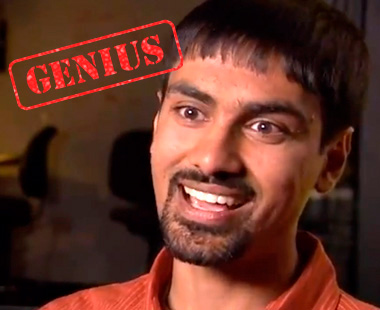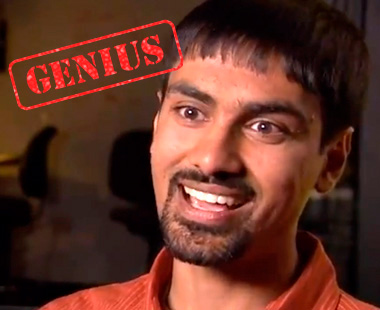 Shwetak Patel.Got your undies all in a bundle about Facebook’s latest infringements on your privacy? Pshaw. Twenty-nine-year-old Shwetak Patel, an assistant professor in all manner of tech-related fields at the University of Washington, dreams of a not-so-far-off day when computers monitor our every breath. (His cell phone is already monitoring his.) When you and I were monkeying around playing Donkey Kong, the 8-year-old Patel was designing his own computer games on an old TI 49A, and it’s been full throttle since then. His clean energy ideas just got a turbo boost in the form of a five-year, half-million-dollar “genius award” from the MacArthur foundation. We asked him where he thinks the house of the future is headed — and how we can all get access.
Shwetak Patel.Got your undies all in a bundle about Facebook’s latest infringements on your privacy? Pshaw. Twenty-nine-year-old Shwetak Patel, an assistant professor in all manner of tech-related fields at the University of Washington, dreams of a not-so-far-off day when computers monitor our every breath. (His cell phone is already monitoring his.) When you and I were monkeying around playing Donkey Kong, the 8-year-old Patel was designing his own computer games on an old TI 49A, and it’s been full throttle since then. His clean energy ideas just got a turbo boost in the form of a five-year, half-million-dollar “genius award” from the MacArthur foundation. We asked him where he thinks the house of the future is headed — and how we can all get access.
Q. Much of your work revolves around this concept of “ubiquitous computing.” Are computers not ubiquitous enough as it is?
A. The concept of ubiquitous computing was postulated in the early 1990s. Now we’re in an era when ubiquitous computing is becoming reality. The question today is about seamless integration. My lab encompasses human-computer interface all the way to students that are working to develop low-level hardware and sensors.
Q. Um … what?
A. A third of our work is in the area of energy monitoring. Eventually we will have sensors everywhere in the environment. These sensors will give you access to high-resolution, high-quality data on energy-use in the home — electricity and water. We’ll feed that data to the homeowner so they can make better decisions — to reduce consumption or update to better appliances. We’ll even feed that data back to engineers and manufacturers, so they can make the appliances of the future.
Q. So I’ll be able to come home and geek out on where every drip of electricity or drop of water has gone?
A. Exactly right. The problem is that it’s not going to be practical to have consumers install hundreds of sensors in their house, on every fixture and faucet. So the question is how we retrofit existing homes to get that same information.
We looked at how we can create sensors that a homeowner can install that indirectly sense use. We have developed a sensor that literally plugs into an electrical outlet and uses the noise that comes over the power line to infer what appliances are being used. It’s the same for water. We have a single pressure sensor that you plug into a hose spigot. We look at the pressure fluctuations in such a way that we can tell whether it’s a toilet, a sink, a washing machine — and if there’s multiple toilets, we can tell which one. These are ways to produce good data without having to have a really complicated network of sensors.
Q. What kind of a person is going to spend the time to sit down and dig into their energy use or water use like this?
A. That’s actually a really interesting research question. An example I like to talk about is, when you pay your electrical or water bill every month, there’s very little information there. It typically tells you how much water you used in a pretty esoteric unit — CCFs or gallons. With electricity, it’s in kilowatt-hours. Most people don’t even know what that means. We’ve been used to paying our water and electric bills without any knowledge about where it’s going, whereas if you get your telephone bill or your credit card bill, it’s broken down into each interaction.
[I can see a time] when people get their electrical bill, you can turn it around on the back, and there will be an itemization, kind of like a credit card bill. That will give them a sense of, oh, wow, lighting, or a television, or a gaming console is a big consumer.
Different people will want to look at this data in different ways … Others are eco-optimists, who are interested in sustainability. They may want an in-home console so they can track it in real time. The question is, how do we render it so that the average person changes their behavior?
Q. How much impact can a single individual or household really have?
A. Technologists in the ’70s instrumented thousands of homes with sensors and gave people similar feedback. They saw 10 to 15 percent decreases [in electricity use]. Multiply that out over 100 million homes — that’s a huge impact … This could be a game changer.
Q. In your sci-fi fantasies, when you imagine your typical evening around the house, how would that look different than it does now?
A. In the home of the future, we’re still going to do what we do, enjoy life, while all of these mundane things are just happening in the background. When that toilet springs a leak, it notifies you instantly, and the plumber also gets notified. It never develops into that flood in the basement.
I also imagine this environment where your consumption is monitored, but the home itself adapts to it. Let’s say that the family is downstairs, but the lights are on upstairs. With machine learning, the house can say, OK, it’s evening, the lights don’t need to be on upstairs. It knows when people start heading upstairs, it turn lights on, and starts getting ready. You’re starting to already see advances in [artificial intelligence] that can enable this kind of thing.
We talk about empowering the consumer, but eventually, the home is going to empower itself. The home will also start to monitor your health.
Q. My health? This is starting to sound like 2001: A Space Odyssey. When do the machines start taking over?
A. If we have continuous monitoring, there are a lot of things we can do that we can’t do just by going to the doctor once a year. So the house is also monitoring your heart rate or your exercise. And you get a daily or weekly report on your general health, and your doctor has a real-time assessment of your vital signs and conditions.
We’ve come up with a way to use the microphone in mobile phone to detect coughing episodes and correlate that with a particular condition [like asthma] — but also correlating lung capacity. As I’m talking to you on the phone right now, the phone is doing this kind of assessment. Eventually, it will calculate peak flow and lung capacity throughout the day. If you have asthma, it will automatically notify your doctor if there needs to be a change in medication.
Q. Can you share what you’ll do with the MacArthur funding?
A. It’s critical for [low-income families] to get access to this kind of data, but it’s extremely expensive. I may start a nonprofit organization that does that. For kids growing up in the home, there are all these issues of air quality and lead and mold growth. For low-income families, that’s particularly a problem. Lead poisoning turns out to be one of the leading causes of young children being diagnosed with serious health problems.
But one of the nice things about the MacArthur Foundation is that there are completely no strings attached. When they called, they said, “This is the only call you’ll ever get.” You can literally do whatever you want. The philosophy is that if you give creative people money, they will do creative things with it.
Q. No pressure now. The entire world is watching.
A. Right.



